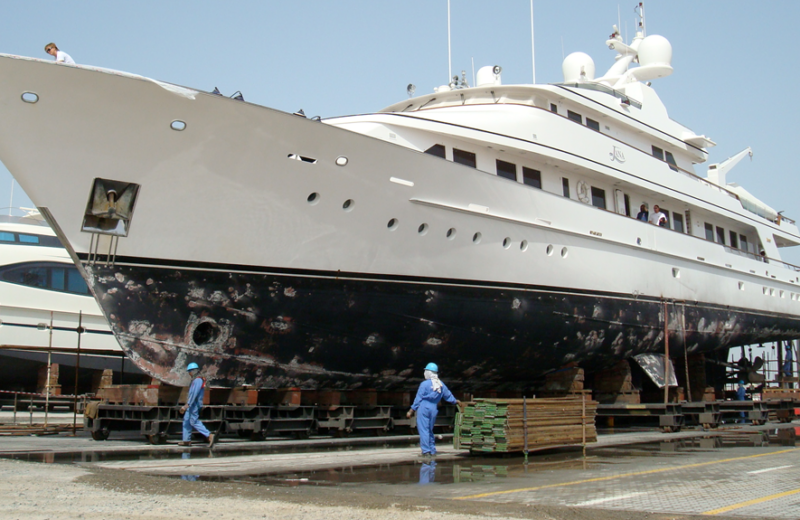View From The Bridge: Introducing the Virtual Shipyard

Virtual shipyards can deliver practical benefits in the real world, according to captain Iain Flockhart.
The concept of the virtual shipyard appears to be gaining popularity, writes captain Iain Flockhart. For those who don’t know what it is, here’s a brief explanation in relation to a more conventional private shipyard.
In a conventional shipyard, the yard owner will have absolute control of the contractors within the yard that would work on any given project. The client will effectively have no choice of contractors outside of the ones the yard owner chooses to use. This can be problematic in certain circumstances.
It can be circumvented in some cases, but generally by accruing substantial additional expense; as yards frequently charge very high levies for an external contractor to enter their yard. This has been something of a sore point with owners and captains for decades.
All other facets of the project are handled and managed by the private yard and their own in-house teams, accounting, client contractor liaison, project management etc.
In an ‘open’ shipyard, such as STP (Servicios Tecnicos Portuarios) in Palma for example, four main infrastructure services are provided by the shipyard owner. These are: berthing, hauling, utilities and land occupation. But all the other work is then carried out by an extensive network of local subcontractors.
Virtual shipyard management
The company providing the virtual shipyard management will take over all the responsibility that would traditionally lie within the conventional private shipyard’s team. They will co-ordinate all the contractors and act as liaison between the contractors and the client. They will take care of all accounting and auditing of the project, liaise with other external regulatory entities such as flag and class. They will also perform all the project management and local organisational, logistical requirements.
Currently there are four basic models that an owner captain can follow for a refit project.
First, you can take your vessel to a facility that provides basic infrastructure and then find your own contractors to do all the required projects. The captain with his team will then have to manage the entire project in house.
Second, you can go to a conventional private shipyard where the yard will supply any contractors that they do not have in house, from their own sometimes limited pool. Organisation and project management is all done in house in conjunction with the captain and crew.
Third, the virtual shipyard offers all the required infrastructure, but you can work with any contractor that you choose. All other logistics and project management will be handled by the virtual yard management team.
Fourth, finally we are starting to see something of a hybrid model where there’s a bit of both worlds. Some previously exclusively private facilities are seeing the advantages of becoming more open.
The main advantages of the virtual model include the fact that the client still has a one-stop-shop, solution for their refit, while offering freedom of choice in terms of the subcontractors they wish to work with without penalty. That is something that is often impossible with a private yard. which may wish to work only with certain local contractors.
Although it’s perfectly possible for a very experienced captain and team to run an efficient yard period without the local knowledge of a conventional yard behind them, it largely depends on them having a lot of essential local knowledge. That can also require strong linguistic skills in the native language.
Essential local knowledge
In many areas there are countless contractors who will claim to be able to perform and deliver, but many are not up to standard. An experienced Virtual yard will be well up to speed with who to use to ensure quality, on schedule budget and delivery. Their choices are likely to be good as their own reputation is riding on who they recommend.
The virtual shipyard management company can ensure proper continuity of a long project when the ship’s crew could be on rotation or leave. Such absences could be problematic if the yacht were on a long project that was not being otherwise overseen and managed in the way a private yard would.
Also there will typically be increased levels of impartiality and transparency due to the nature of the structure, which can be a great comfort to many clients.
As a captain myself, I very much welcome the apparent growth in this model of shipyard. I have endured countless issues in yards over the decades at various levels from the mere frustrating to entirely unacceptable.
I believe the model of the Virtual yard offers an attractive alternative that will help reduce many of the niggly issues that have existed in so many yards for as long as I can remember. I would encourage all owner’s, captains, and managers to consider the emerging options that are now available when considering how and where they will accomplish their next yard period.

About the author
Iain Flockhart, MD, Saor Alba Holdings Ltd, is a highly experienced yacht captain with over 265,000 nautical miles in the role of master since 1996. He bought and completely refitted his first yacht at the age of 20 and went on to buy a larger ocean going yacht a few years later and set sail across the oceans, often with novice crews.
As well as being a master, Iain provides professional mentoring services to yacht crew and advises on issues relating to hiring, managing and retaining the right crew. He’s an ambassador for the exceptional Rafnar brand of RIBs. through his brand brand SA Marine. He enjoys simple pleasures such as using his 7m RIB to go exploring and wild camping in natural beauty of his native Scotland.
Subscribe to our free newsletter
For more opinions from Superyacht Investor, subscribe to our email newsletter.

